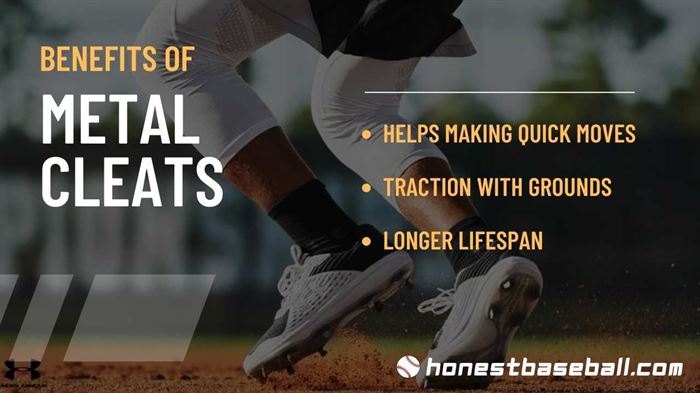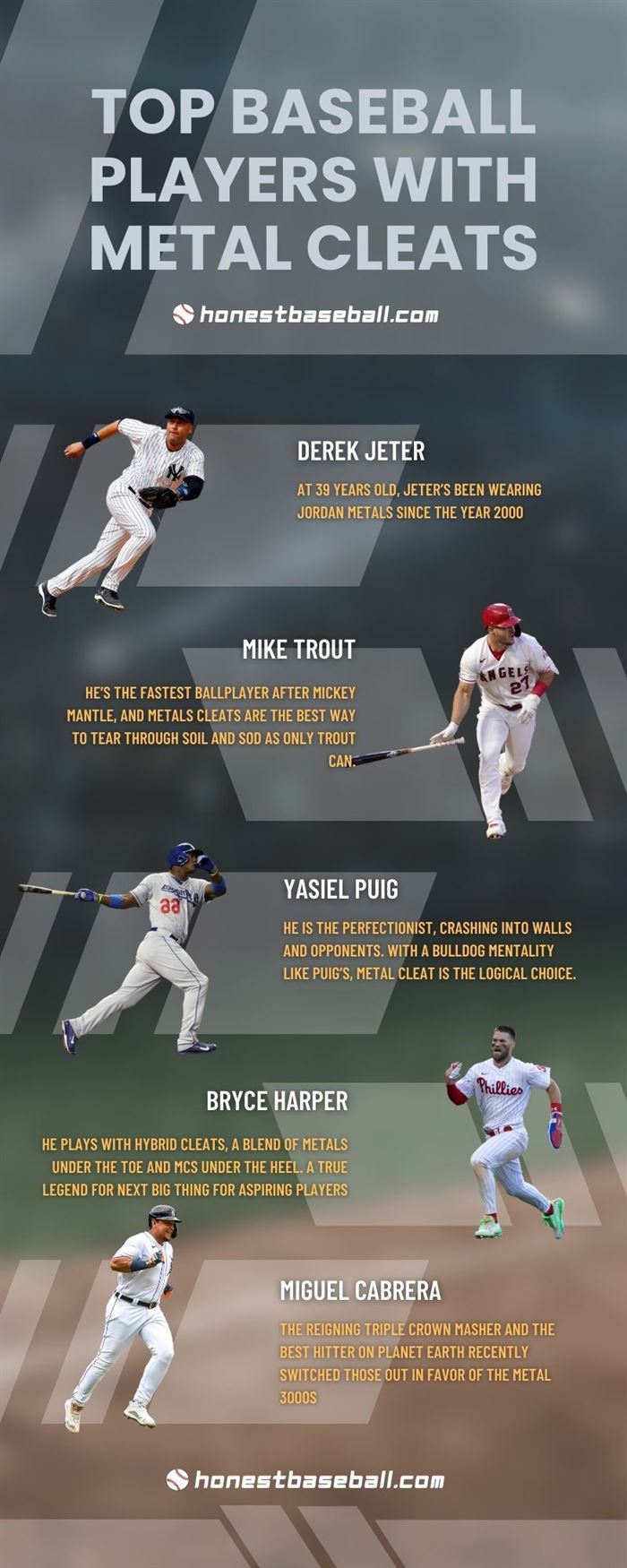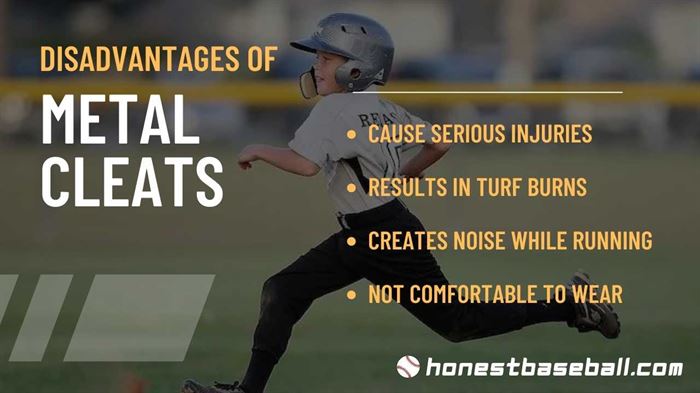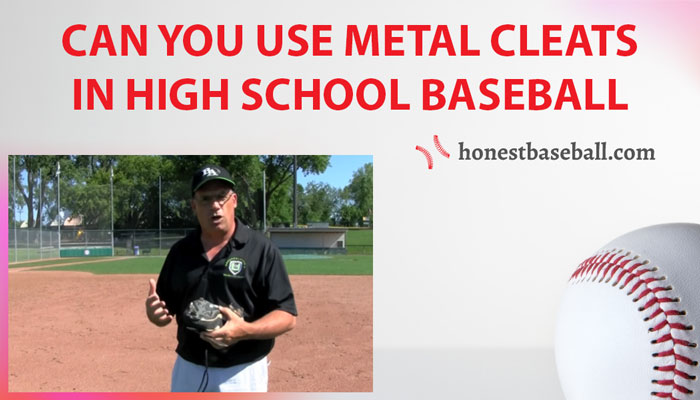Are you scratching your head about can you use metal cleats in high school baseball? Last week, a boy named Travis came for my advice with the same question regarding switching from molded cleats to metal cleats.
This guy is still in 8th grade, but I saw really good potential in him during some practice matches. And I know many of you do have so. So, I decided to help you with the answer.
In recent years, metal cleats have become increasingly popular in baseball. There’s no doubt metal cleats are scientifically proven to improve your baseball gameplay.
But there are some drawbacks too. Read along to learn whether you can use metal cleats or not in high school baseball.
What Are Baseball Cleats?
Baseball shoes are more like soccer or football shoes. They come with a thick and cleated outsole. Those spikes are actually called cleats. However, baseball cleats are a bit shorter than those you see in other sports shoes.
Cleats are not just a common sight in high school baseball. Professional athletes also rely on them to help them play their best game possible.
When running, cleats give you more traction and makes it easier to grip the ground when making a pivot. Baseball cleats also help players dig into the ground when swinging.
You can find several different types of baseball cleats out there, including metal spikes, molded rubber or plastic cleats, and turf cleats.
Why Should You Wear Metal Cleats?
Like most sports, the right equipment can give you a competitive edge in baseball too. But are metal cleats better for baseball? Well, they are helpful in some ways. Here are the reasons why you should wear metal cleats:
- They provide good traction on both grass and dirt surfaces, which can help you make quick cuts and sprints.
- Metal cleats have a longer lifespan than other types of cleats. They can handle tough play without wearing down quickly like some other types of cleats might.
- For getting more stability and support, metal cleats are a great choice.
- As you get a good grip on the ground, you can achieve a better grip on the bat, which can improve your batting accuracy.
- Without the above, metal cleats are preferred by many pro-league batters, especially when they are on a full walk off aggression.

While there are some variations among different types of cleats, they all serve a common purpose: to improve performance and safety on the field.
Metal cleats provide a number of advantages depending on your roleplay, especially in the hardest positions on the baseball ground.
Metal Cleats For Infielders
Infielders need the best traction possible to make quick and accurate throws. Metal cleats provide the right grip on the field and are less likely to get stuck in mud or sand. They also protect the feet from injury because of their thicker sole nature.
Metal Cleats For Outfielders
This is important for outfielders, who often have to make plays in difficult conditions. Metal cleats allow players to move more quickly and change direction more easily.
The facility is critical in making catches or getting to ground balls before the opposing team does.
Metal Cleats For Pitchers
Baseball is a game of inches. And in the heat of competition, even the slightest advantage can make all the difference.
That’s why metal cleats have become an essential piece of equipment for pitchers, who need every possible edge they can get to gain an advantage over the batter.
Metal cleats provide more traction than traditional rubber cleats, allowing pitchers to plant their feet more firmly on the ground and get more leverage on their pitches.
This extra grip also helps them keep their balance in different pitching styles, such as the cutter pitch.
Top Baseball Players With Metal Cleats

NFHS Baseball Rules Metal Cleats
Can you wear metal cleats in high school baseball? Partially yes! Rules for different types of cleats have been changed after their introduction in 1862 by Paul Butler.
Regarding the metal cleats, the regulation varies depending on states and tournaments.
For instance, The National Federation of State High School Associations banned metal cleats in 2016. It happened after some incidents occurred in different high school baseball tournaments.
“According to NFSH 2016 baseball rulebook, caps and shoes are required but no track spikes are permissible – Stated under section 4, Art: 1)”
The good part is in early 2020, NFSH again flexible the regulation on metal cleats. But there are still some guidelines to follow, such as only 13U players and above are allowed to wear metal cleats.
Some states refused to adopt this rule, including New Jersey, Massachusetts, and Maryland.
Disadvantages Of Metal Cleats
As a manager, I often saw many amateurs decide to switch to metal cleats without knowing the other side. Using metal cleats does not only offer you benefits. There are some disadvantages too.
So, I always advise my team to understand these facts below before switching to metal cleats.
The first disadvantage is that metal cleats can cause serious injuries if they come into contact with another player’s skin.
They can also lead to more turf burns since they grip the ground more tightly than traditional cleats.
Additionally, metal cleats can be quite loud, which can be distracting for both players and spectators.
Lastly, they tend to be heavier and less flexible than other types of cleats, making them more difficult to wear for long periods.

If you are confused between molded and metal cleats, check out this comparison article of metal and molded cleats.
Why Are Metal Cleats Not Allowed?
Metal cleats are not allowed in some tournaments because they can cause too much damage to the playing surface.
The cleats can tear up grass fields and even concrete surfaces, leading to costly repairs. In addition, metal cleats can be dangerous for other players if they get in contact with them.
Just like restrictions with metal cleats, some bats are also not permitted in baseball. Find when a baseball bat is considered illegal in this article.
How To Remove Metal Cleats From Baseball Shoes?
Yes! You can change or replace metal cleats from baseball shoes. In order to do that, follow the below instructions.
Required Components:
- Cleaning Brush
- Paper Towel
- New Metal Cleats
- Cleat Wrench
Step 1: Clean The Soles & Cleats
You need to wash down your cleats to get rid of dirt in the first step. Use a stiff-bristled brush with a q-tip or paper towel to scrub the bottom of the shoe. Do a concentrated brushing near the cleats.
Step 2: Eject Worn Cleats
Now start rotating the worn cleats counterclockwise to eject them from the shoe’s sole. You may see some dirt still left under the cleat area where the brush couldn’t reach. So, brush there again.
Step 3: Align New Cleats
Count how many cleats you need. In general, replaceable cleats packs come with multiple units more than what you require. Now pick the newly brought metal cleats.
There are usually two components in good metal cleats – cleat piece and fastener. Now place a cleat in the receptacle. Make sure to align the notch on the heel side of your baseball shoe. The fasteners will rise out of the cleats when you try the alignment.
Step 4: Torque Cleats
Next, use the cleat wrench to tighten the fastener. When fastening, ensure that the cleat piece is in the right position.
After finishing up the fastening, double-check whether the alignment notch is positioned towards the heel side of your shoe. Lastly, repeat the same steps for every cleat.
Frequently Asked Questions
Are Metal Cleats Allowed In Little League?
That is a question that I hear a lot every season from new players on my team. The answer is yes for seniors and no for juniors. According to the Little Leagues rulebook, you can only use molded baseball cleats. They explicitly banned using metal cleats.
Even for seniors, there are some restrictions. Metal cleats can only be worn in games, not in practice. However, you can wear plastic or rubber cleats in Major, Minor, and Tea Ball.
Are Metal Cleats Allowed In Softball?
In the common softball scenario of most of the junior leagues or tournaments, you cannot use metal cleats. This is nothing but for players’ safety.
But they are allowed in Junior Olympic softball under 14U, 16U, and 18U divisions, both for slowpitch and fastpitch softballs.
Can You Wear Metal Cleats In 13U Baseball?
Yes! The permitted age for using metal spikes and toes is 13U and above players in baseball. Both of the prominent federations of baseball, NCCA, and NFHS, have allowed this.
Conclusion
Can you use metal cleats in high school baseball? Hopefully, you get your answer. I will not say metal cleats are bad or good. Because all types of cleats have pros and cons but somehow serve the same purpose.
I will also not argue with the decision of NFHS on restricting metal cleats for under 13 years of players. As baseball is a rush sport, often players get close interactions during the play.
Metal cleats can cause injury then, especially in high school baseball tournaments. So, what is your thought about metal cleats?

Hello everyone. My name is Jason Butler, and I live in California, America. I was a professional AAA Minor League Baseball player. I lost my chance of playing MLB for injury issues, but I did not lose my love for baseball. I attended the coaching training program and am now working as a coach in a small school in San Diego.
I always love to share my experience and knowledge if that can help you. Play baseball, and stay fit.
